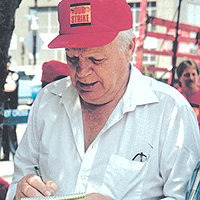With the official count of the unemployed still increasing, economists who are predicting an early end to the present recession should remember the old adage about not counting chickens before they hatch, as they gaze into their crystal ball. The numbers tell the story:
• As of Dec. 7, some 8.2 million workers were without jobs, an increase of 2.6 million since last October, as the unemployment rate jumped by 1.8 percent during the same period. Both increases were the largest for any 12-month period in nearly 20 years.
• The official unemployment rate for November, 5.7 percent, is the highest since the summer of 1995.
• The count of the unemployed increased by 0.8 percent in October and November, the largest two-month increase since April/May 1980.
With some 163,000 layoffs in November, manufacturing industries now represent 15.5 percent of all private-sector employment, down from 17.9 percent in April 1998. The decline in the number of jobs (331,000) was spread broadly throughout the economy: Temporary help down 18 percent since its high in April 1998; wholesale and retail trade continuing their downhill slide and air transportation down 45,000 – a clear indication that the earlier $15 billion bailout of the industry has done little to prevent job loss. No demographic group escaped the flurry of pink slips in November:
• Unemployment rose for all educational levels, with the biggest increase – from 1.6 percent to 3.1 percent – among college graduates. Unemployment for high school dropouts rose from 6.6 percent to 8.1 percent.
• The unemployment rate for adult men (5.3 percent) and white workers (5.1 percent) rose in November while the rates for adult women (4.9 percent), African Americans (10.1 percent), Latinos (7.6 percent) and teenagers (15.9 percent) were little changed from a month earlier.
• The unemployment rate for women who maintain families (8.3 percent) increased by 3.1 percentage points over the past year. This was the largest 12-month increase for that population since the period December 1981 to December 1982.
Other numbers are equally disturbing: The number of workers the Labor Department says are “marginally attached” to the labor force – those who were “available” for work but were not counted as unemployed because they had not searched for a job in the previous four weeks – increased by 200,000 in November and now stands at 1.3 million. The number of “discouraged workers” – those who have given up searching for non-existent jobs – stood at 322,000 in November.
Although recent reports regarding consumer spending, industrial activity and the stock market recovery since 9/11 have led many analysts to conclude that the recession is bottoming out and that overall economic growth will soon turn positive, spurring a growth in jobs, economists at the Economic Policy Institute (EPI) do not share that view.
“Whether or not these forecasts are accurate, in terms of jobs and earnings, simply moving from negative to positive growth will not prevent unemployment from rising further.
The unemployment rate will continue to increase until the economy returns to growth rates of at least 3 percent; returning to an unemployment rate of 4 percent, which should be the goal, would require even faster growth,” Jared Bernstein, EPI director, said. Thus the challenge:
To force Congress to deal with the situation where thousands – soon to be millions – of unemployed workers have exhausted their unemployment benefits and the more millions who are ineligible for benefits.
But important as that is, longer-ranged and more fundamental solutions are necessary. Historically the labor movement has fought to reduce the hours of labor as a means to protect and create jobs – and there’s no reason that fight should not be renewed today. Samuel Gompers’ admonition, “so long as there is one man who wants work and cannot find it, so too are the hours of labor too long” is just as true today as when he uttered it during the campaign for the eight-hour day.
There’s a second front in the campaign for jobs – public works. Here again there is historic precedent; the public works projects that helped pull the country from the depths of the Great Depression. That, campaign, too, should be reopened. As the labor movement has often said, “If private industry can’t or won’t create jobs, then government must.”









Comments